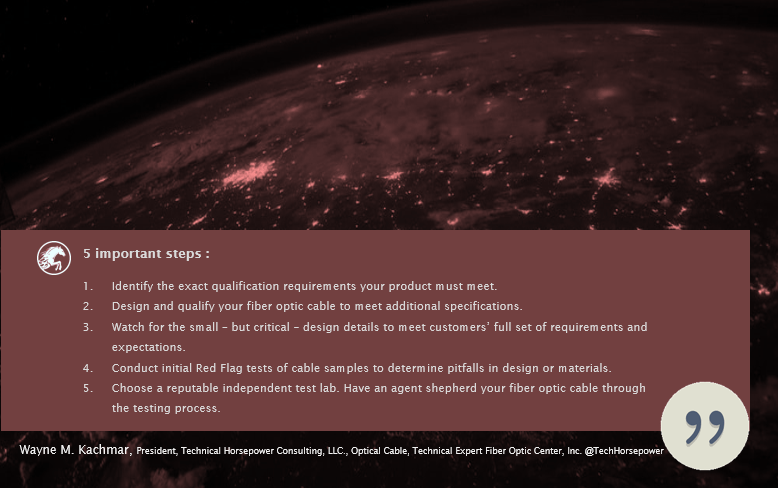I am seeing a trend in the fiber optic industry: Cable manufacturers around the world are looking to develop and qualify cable designs in order to enter the US fiber optic market.
Unfortunately, I am witnessing another trend: Many cable manufacturers don’t do enough research prior to designing their products to meet US qualifications. At the testing stage, they encounter disappointing failures. They must step back to redesign and retool. This costs time – and tens of thousands of dollars.
There are many differences from cable manufacturers’ home markets or even moving from Datacom to telecom type cables and testing. When consulting with manufacturers, I can provide help in understanding not only what is required, but how to actually interpret what is required. This includes guiding them past the many potential pitfalls to develop, test, and successfully qualify their fiber optic cables for the American market.
If your company is looking to enter the US fiber optic market, I encourage you to keep reading.

Here are 5 important steps you’ll need to master to successfully develop and qualify a fiber optic cable for the US marketplace:
One. Identify the exact qualification requirements your product must meet.
Before developing your fiber optic cable, you must understand who you’re qualifying your product for – and the exact specifications you must meet. There are a number of qualifications. For instance, Telcordia is essentially a baseline industry standard with several cable categories. Telcordia’s GR-20 specification refers to outdoor cables, while GR-409 refers to indoor cables. Each category has many subcategories for various cable types, each with its own set of qualifications. For example, GR-409 presents standards and test values required for an interconnect cable, miniature interconnect cable, riser cable, backbone cable, and so forth.
Verizon has created its own specification series called TPRs (Technical Purchase Requirements). A large telecommunications user, Verizon has created thousands of specifications relating to every product the company buys, including fiber optic cable.
When entering the US fiber optic market, you must identify and fully understand the applicable specifications prior to developing your cable. While this first step can be overwhelming, it’s absolutely critical. I have a depth of experience in the qualification requirements of Telcordia, Verizon TPRs, REA (Rural Utilities Commission), and other US standards. My consulting clients often express relief as I guide them through this maze to clarify the exact specifications for their products.
Two. Design and qualify your fiber optic cable to meet additional specifications.
Here’s something that further complicates the qualification landscape: You need to design to additional American standards. For example, indoor fiber optic cables must meet specific flame retardancy and safety specifications. This means you must design your fiber optic cable to pass the qualification requirements AND meet additional US-required specs to be accepted for the end user’s application.
While your product may meet European standards such as IEC (International Electrotechnical Commission) or regional or country-specific standards such as Spanish Telefonica, it will need to be designed differently to meet US standards. This is a surprise to many cable manufacturers entering the US fiber optic market. On a related note, it’s a good idea to look at your competitors’ products. See how they designed their fiber optic cables and be aware of US patents and intellectual property you need to work around.
Due to my decades in the fiber optic industry, I have experience in designing and qualifying fiber optic cables to meet all types of qualification requirements. I’m very familiar with the specifications – and what the end users are looking for.
Three. Watch for the small – but critical – design details to meet customers’ full set of requirements and expectations.
In many cases, end users’ specifications will reference Telcordia, Verizon TPRs, or other standards. Plus, they will list individual items that are specific to their needs. It’s important to understand the written specifications as well as the perceived final product (what the customer actually wants).
Here’s an example: Let’s say your cable manufacturing company has designed and built a low-smoke, zero-halogen cable. You believe this patch cord meets all customer specifications. Your patch cord may pass all tests, yet it’s not accepted by the customer. Why? You missed the UL OFNR specification. The Optical Fiber Nonconductive Riser spec is an American burn test, which is a UL standard (UL 1666). Many cable companies that are not based in the US have never encountered this specification. Your company may have spent tens of thousands of dollars in the qualification process, only to find that the cable is rejected by the end user. Many requirements are not even that clear. Some perceived requirements may relate to a company’s existing installation practices or installation hardware such as a certain type of cable clamp or pulling device.
When I consult with my global clients, I provide design commentary to ensure their products will fully meet their customers’ requirements and expectations. Identifying these small, vital details ahead of time can save significant time and money.
Four. Conduct initial Red Flag tests of cable samples to determine pitfalls in design or materials.
I find that many cable manufacturers entering the US fiber optic market don’t have a thorough, accurate understanding of the testing procedures in US-based independent test labs. Once these companies have developed their fiber optic cables, they ship them to test labs to undergo 40 to 45 different – and expensive – tests.
Here is a simple concept that can be extremely helpful: Strategically conduct certain tests first. These are known as Red Flag tests. If the product doesn’t pass, there’s no need to spend money completing all other tests. (An example Red Flag test is the Properly Designed Impact test for small, interconnect cables.)
Over the decades, I’ve spent much time in independent test labs. (I even helped to write some of the tests.) I have set up a full test lab and, often, my clients who do not have American-style test fixturing will ask me to run Red Flag tests on cable samples instead of running a full battery of tests at an independent test lab. Red Flag testing allows us to quickly understand what works and what doesn’t. If the product doesn’t pass a Red Flag test, I guide them to conduct targeted rework as necessary.
Alternatively, I can set up Red Flag testing capabilities in cable manufacturers’ labs, train their engineers to conduct Red Flag tests, and teach them how to interpret the results.
Five. Choose a reputable independent test lab. Have an agent shepherd your fiber optic cable through the testing process.
Did you know that some independent test labs outsource 90% of the testing? For instance, a biochemical test lab might only conduct material fungus testing in house, then farm out all mechanical testing. It’s critical to choose a viable independent test lab – one with a reputation of being successful and doing most of the work in-house.
Compounding this issue, it’s important to recognize that no test lab is intimately familiar with every specification. Here’s an example: EIA/TIA FOTP 45 is a specific test procedure for impact testing. The test lab may only conduct this impact test a few times a year. In many cases, the test technician follows a written procedure, which may or may not be detailed enough.
Some of my clients hire me to recommend a viable independent test lab for their product. I may also be tasked to act as their agent, shepherding their cable through the testing process. Having a set of “calibrated eyes” on testing is critical to success. For the above example, I would verify that:
- The technician keeps the cable straight, with no looseness in the cable.
- The impact tester is calibrated, ensuring it has the right load on it.
- The cable is accurately placed in the environmental chamber, so there is no high loss bend.
Often, a client’s engineer will accompany me at the independent test lab. I can teach and mentor the in-house person, so they learn the testing processes and methodologies.
Conclusion
It is important that you understand how to validate your product, as opposed to verify your product. Product verification means you have a quality management system in place, which verifies that each cable produced is the same. More important, product validation means you have tested to ensure the design meets certain qualifications, and the design of your fiber optic cable can meet all specified extremes. If your company is serious about entering the US fiber optic market, it’s critical to implement a validation process for your fiber optic cable.



